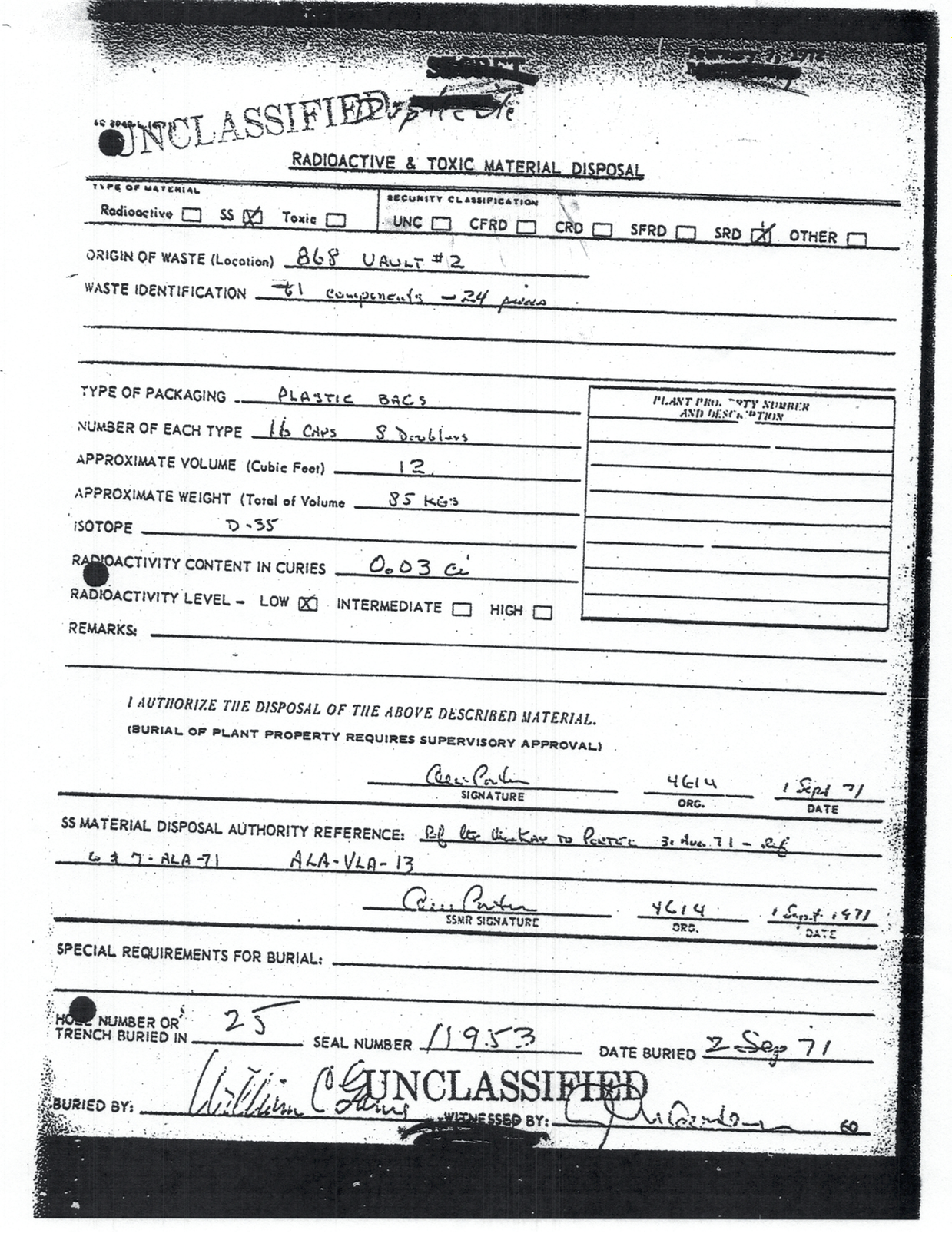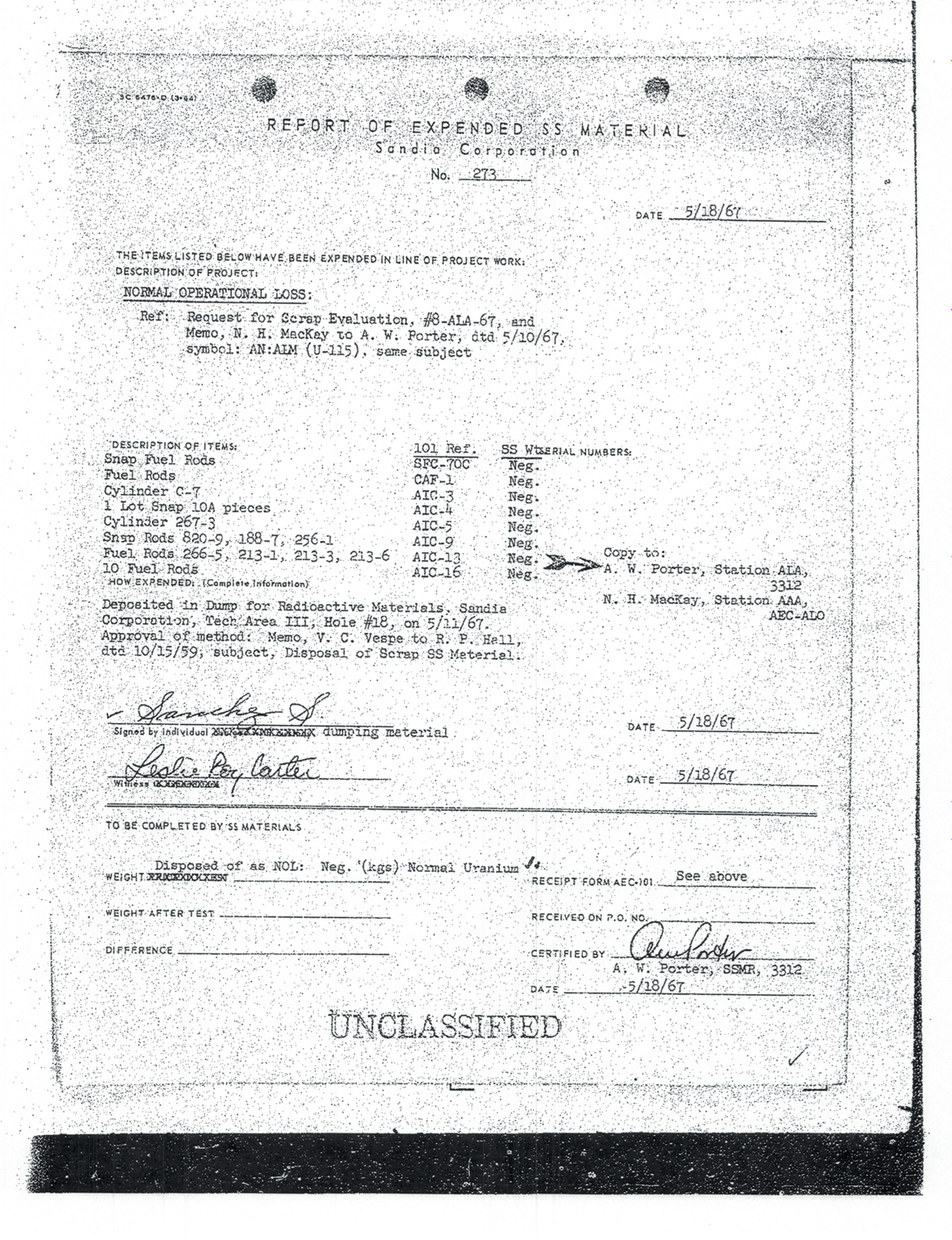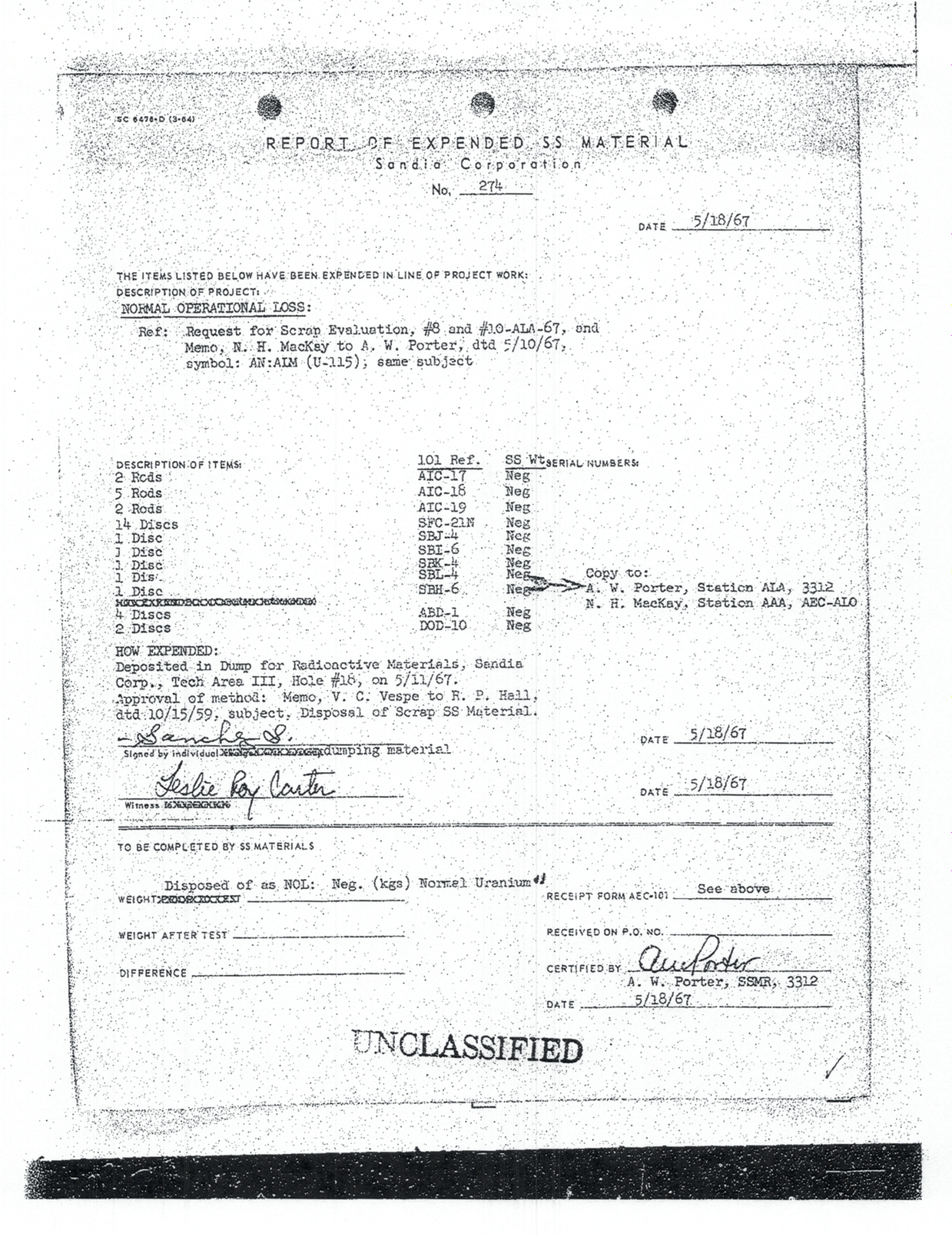BEFORE THE SECRETARY OF THE ENVIRONMENT DEPARTMENT
IN THE MATTER OF THE MIXED WASTE LANDFILL (MWL)
SANDIA NATIONAL LABORATORIES (SANDIA)
APPLICATION FOR CORRECTIVE ACTION COMPLETE (CAC)
Comments on the Hearing Officer Report by Citizen Action New Mexico
and Dr. Eric Nuttall, Ph.D.
The Secretary should reject the findings and conclusions of the Hearing Officer (HO) and order the establishment of a timetable for the excavation of Sandia National Laboratories’ (Sandia) Mixed Waste Landfill (MWL). The conclusions of the HO that the Sandia Permit should be modified to allow Corrective Action Complete (CAC) with Controls for the MWL can only be reached by ignoring the law, the facts and the concerns of the public.
The MWL is clearly a very complex and hazardous waste site. Its contents are extremely toxic and radioactive. The MWL contains High Level Mixed Nuclear Waste (HLMW).
“DEFINITION OF HIGH-LEVEL WASTE
High-level waste is also defined as:
-
Other highly radioactive material that requires permanent isolation.”
DOE M 435.1-1, Chapter II, High-Level Waste Requirements.
The record of Radioactive and Toxic Material Disposal Sheets categorically shows high level nuclear waste disposal in the MWL in the form of spent fuel, fuel pins and rods from nuclear meltdown tests, atomic bomb test material experiments, and nuclear rocket testing. Metallic sodium that is explosive and can cause fires was deposited with the high level waste. Sandia Memoranda (1997-98) indicate canisters from nuclear reactor meltdown experiments containing 4 melted fuel pins and metallic sodium were disposed of in Pits 35 and 36. Canisters were put into holes drilled in the bottom of the trenches and no additional information was provided for location or contents.
With respect to High-Level Waste, irradiated fuel pins were disposed of in the MWL from multiple sources. Examples are attached as: 16 fuel pins from the nuclear reactor meltdown experiments, SS disposal of 24 U-235 fuel pins, and 28 fuel rods from the Space Nuclear Auxiliary Power Program (SNAP). The SNAP disposals were not listed in the 2002 Inventory for the MWL but were found among the approximately 6000 disposal sheets. The HO failed to address the issue of HLW from SNAP. (See Appendix A).
The remedy of a dirt cover for HLMW was and is legally invalid because deep geologic disposal is required for disposal of HLW. Whether the cover was properly installed is irrelevant to the fact that the cover is not protective of human health and the environment due to the presence of long-lived radionuclides. The MWL is already leaking its toxic contents.
The MWL inventory is incomplete with much of the disposal still being kept as a military secret in the Classified pits area of the MWL. Many Radioactive and Toxic Material Disposal sheets only indicate that polypropylene (“poly”) plastic bags, wooden or cardboard boxes, cans, canisters, drums and barrels were disposed of in unspecified locations without specifying the contents. Many of the disposal sheets are redacted. Long-lived radionuclides such as plutonium, americium and uranium-235 in flimsy plastic bags and containers were haphazardly thrown in the shallow, unlined pits and trenches. No risk assessment was performed for unknown contents that are now being released from corroding barrels and deteriorating containers. This leaves a dangerous legacy of unknown amounts of toxic chemicals and radionuclides.
The HO report is a victory only for the DOE and Sandia as polluters and leaves the public health and environment at extreme risk. Two uranium fires have already occurred at the MWL. On October 19, 2015, an explosion and fire occurred at a low level nuclear mixed waste dump site at Beatty, Nevada that required shutdown of Highway I-95. The Beatty dump was closed in 1992 and is very similar to the Mixed Waste Landfill with shallow trenches and a ten foot dirt cover, compared to the 5 ft MWL dirt cover.
Unlike the Beatty site, the MWL contains HLMW. A fire and explosion at the MWL, with the spread of high level nuclear waste, would probably require closure, evacuation and decontamination of areas such as the Sunport, Isleta Pueblo, Sandia Labs, Kirtland AFB, Highways I-40 and I-25, the VA hospital, offsite neighborhoods and businesses. An MWL explosion and fire could spread Plutonium and Americium in Albuquerque just as happened with the WIPP explosion in Carlsbad, NM. There is no specific emergency plan. The NMED proceeds with the approval of the CAC at the peril of this and future generations in Bernalillo County.
Basically, the HO Report refuses to consider information that has been obtained since the issuance of the 2004 Final Order for the MWL. The fact of high level waste disposal in the MWL must be a finding of the HO. RCRA requires that incorrect or omitted information provided at any time must be corrected in the record. The most fundamental issue that the HO fails to address is that the MWL contains HLMW and that the dirt cover cannot be protective of public health and the environment for long-lived radionuclides that are legally required to be disposed in a deep geologic repository. The entire premise of the Department of Energy (DOE) and Sandia for the installation of the dirt cover and CAC was that the MWL was a low level mixed waste landfill, which it is not.
DOE and Sandia should not be allowed to benefit from deliberate mischaracterization of the MWL to obtain CAC. The Sandia application for CAC status for the MWL is improper because Sandia has not fully disclosed the nature and toxicity of high level mixed nuclear waste containing metallic sodium that was disposed of in the MWL. Thus, the application for CAC status does not address the full inventory of what was actually disposed of at the MWL so that the dirt cover cannot be considered as adequate to protect public health and safety and the environment.
The dirt cover, no matter how well constructed, cannot be protective for the hundreds of thousands of years that high level radioactive waste remains toxic. The dirt cover must last for perpetuity, according to Sandia Labs. However, Dr. Robert Dinwiddie, former hazardous waste bureau chief at NMED, stated that dirt covers usually last no more than 25 years and are worthless without a liner beneath them.
NMED may lack the authority to regulate the radioactive portion of hazardous waste, but it should not stand idly by while the contents of the dump are deliberately mischaracterized in violation of federal law. RCRA requires new information to enter into the permitting process.
The HO did not consider new information or information that was previously available and the new understanding that must be accorded such information. The information includes that the groundwater monitoring well network is defective. As the EPA Inspector General pointed out in 2010, the public was denied meaningful participation in the RCRA process by NMED and EPA Region 6 because the facts about the defective monitoring network were not revealed to the public. The groundwater monitoring network remains defective for many reasons for detection of contamination.
New information includes the 2006 TechLaw, Inc. report, withheld from the public that found the dirt cover construction is defective for even a thousand year period and also because there is no liner beneath the cover to carry leachate to the sides of the cover for collection.
The MWL was and is not qualified or eligible to receive CAC status because it is a “regulated unit.” Regulated units are not applied for. They are not designated by regulators. They are statutory.” (Tr 933, l.22-23). A regulated unit is a species of a Solid Waste Management Unit (SWMU). By legal definition under RCRA, owners and operators of landfills that received waste after July 26, 1982 are regulated units. (40 CFR § 264.90(a)(2)). As a regulated unit, Sandia is required to obtain a post-closure permit for the MWL facility, unless closure by removal of the wastes was demonstrated. (20 NMAC 4.1, Subpart IX, 40 CFR § 270.1(c). Sandia has not removed wastes from the MWL. Sandia did not submit a closure plan or a post-closure application to meet the requirements of 20 NMAC 4.1, Subpart VI, 40 CFR § 265.110-120 and § 265.310.
The Long-Term Monitoring and Maintenance (LTMMP) Plan fails to impose the groundwater monitoring requirements for the MWL as a regulated unit. The defective nature of MWL groundwater monitoring wells has been known since at least 1991. The 2010 EPA OIG report acknowledged the withholding of information about the defective groundwater monitoring network. The newer wells installed in 2008 remain defective. There is continued use of monitoring wells MWL-MW4, MW5, and MW6 that were known to be defective from the time of their installation. Monitoring wells MWL-MW7, MW8, and MW9 are defective for other reasons brought forward in testimony by Dr. Dinwiddie and Dr. Barcelona.
Attached for inclusion in these comments are the Facts and Conclusions of Law with Recommendations of Citizen Action New Mexico and Dr. Eric Nuttall, Ph.D.
CONCLUSION
Corrective Action Complete with Controls should be denied, an immediate 5-year review for feasibility of excavation should be performed and a schedule for excavation of the MWL should be imposed. Excavation is the only protective remedy for protection of human health and the environment from the toxic long-lived radionuclides that must be permanently isolated.
October 31, 2015
David B. McCoy,
Executive Director
Citizen Action New Mexico
POB 4276
Albuquerque, NM 87196-4276
505 262-1862
Dr. Eric Nuttall, Ph.D.
1445 Honeysuckle Drive NE,
Albuquerque, NM 87122
505 269-7840
APPENDIX A
The Radioactive and Toxic Material Disposal Sheets in Appendix A are examples of high level nuclear waste disposal in the MWL in the formof spent fuel, fuel pins and rods from nuclear meltdown tests, atomic bomb test material experiments, and nuclear rocket testing. The more than 6000 actual disposal sheets were only obtained as a result of a Citizen Action Freedom of Information Act request.
24 PINS OF SS MATERIAL WITH 85 KGs OF U-235 DISPOSED OF IN TRENCH 25 ON SEPTEMBER 2, 1971

Sheet 5/18/67 for #273 – Hole #18 Snap Fuel Rods; Fuel Rods; Cylinder C-7, 1 lot of SNAP-10A pieces, Cylinder 267-3, Snap Rods 820-9, 188-7; 256-1; Fuel Rods 266-5, 213-1, 213-3, 213-6; 10 Fuel Rods.

Sheet 5/18/67 #274 -- 2 Rods (AIC-17); 5 Rods (AIC-18); 2 Rods (AIC-19); 25 discs.



